While reading myths, Vedic sources, studying signs and symbols, and based on the Primordial Knowledge given in the books by Anastasia Novykh, I have noticed that some images frequently used in all these sources (despite the fact they are depicted and called differently) symbolize one and the same concept – the one that may be figuratively referred to as the Bridge. I wrote on this subject in my earlier article Chinvat. The Bridge over the Abyss, but for those who haven’t read it I should briefly explain: what is meant here is the symbolic Bridge-Passageway signifying the spiritual Knowledge that helps human personality pass from the material world into the spiritual world – the world of God. It may otherwise be said that “the Bridge is what helps human personality merge with the Soul”.
Throughout the history of mankind the knowledge of the Passage to the spiritual world was left by knowledgeable people in various forms and sources. Now such Knowledge is available to us in ancient myths and fairy tales, on ritual items, and even in architecture of cult buildings and structures.
What do such images have in common, and why have I brought them to a single image of the Bridge?
Let me respond: in one way or another all these images contain information about the spiritual world and the material world and their correlation, as well as about energies originating from the world of God and creating Life in the broadest sense of this word. As a rule, such symbolist concepts as “heaven” and “earth” are present in the images, i.e. that what signifies the spiritual and material worlds. Or, as a rarer version, there is an idea of the three worlds – Pravi, Yavi and Navi – with an indispensible median structure, a sort of an axis mundi that links “earth” and “heaven”, upper and lower levels. This may be a mountain, a pyramid, a sword, a crosier, etc. Familiar shapes, aren’t they?
On such images there are usually steps, scale divisions, measure points, spiral turns, etc. separating one world from the other or one dimension from another. Speaking of “subtle” dimensions, very often we can notice such a pattern when the number of steps, stages or dimensions equals to the seven numbers that are most important for human spiritual development: the six lower dimensions and the crowning seventh dimension. At that, the Bridge image often includes the Pyramid symbol which according to the Primordial Knowledge given in the AllatRa book signifies the human energy structure, the Soul, and the Aspects. More details about the human energy structure and the pyramids may be found in the following articles:
What other common features do such images have? The concepts of Life, spiritual immortality, the world of God, spiritual purity, etc. which is frequently reflected in symbols of Lotus, chalice, life-giving water, or the concepts of a beverage (e.g. soma, ambrosia) that is drunk by Gods. Such beverage is usually guarded and accessed by guards, e.g. serpents, dragons, sphinxes, and so on, which are very often included in the BRIDGE image.
The aforesaid deep symbolism demonstrates that in the “hoary antiquity” human Knowledge of the spiritual world considerably excelled the knowledge of contemporary people who interpret ancient myths and symbols from diverse views and perspectives, yet unfortunately solely materialistic ones. The knowledge about human spiritual development has been obliterated from the memory of contemporary mankind. At that, let me give some examples of symbols which I consider similar to the BRIDGE concept, i.e. to the sacred knowledge of surmounting the six lower dimensions of the material world and merging of human personality with the Soul – entry of the new spiritual being into the seventh dimension.
KNOWLEDGE OF THE WORLD TREE
For instance, there are myths bearing Knowledge of the World Tree as a symbol of the universe and the axis mundi.
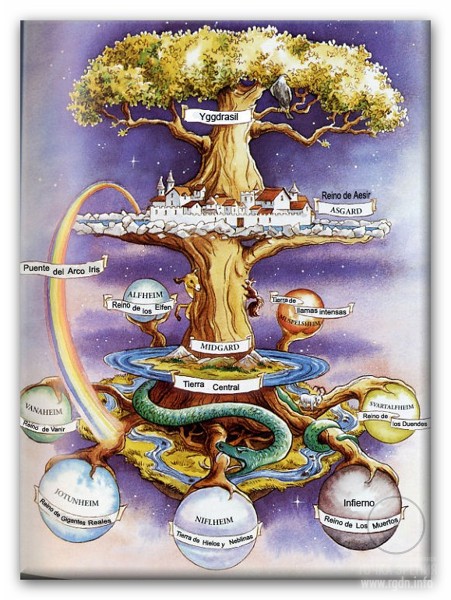
The World Tree concept is found in various cultures: in Slavic, Scandinavian and Turkic myths, in ancient Iran, Hindu Vedas, Kabbalah, etc. By the way, the Koran contains a very interesting image of the Tree – Sidrat al-Muntahā, the Lote-tree, or “the extreme Lotus”. Do you remember these lines in the Koran?
The (Prophet's) (mind and) heart in no way falsified that which he saw.
Will ye then dispute with him concerning what he saw?
For indeed he saw him (Jibrail) at a second descent,
Near the Lote-tree beyond which none may pass,
Near it is the Garden of Abode.
Behold, the Lote-tree was shrouded (in mystery unspeakable!)
The Vedic knowledge of Mount Meru may be considered an analogue of the same concept. It’s a sacred mountain in Hindu and Buddhist cosmology, regarded as the centre of all material and spiritual universes. It is considered to be the abode of Brahma and other deities. In the Hindu tradition the universe is often depicted as a lotus, in the middle of which Mount Meru towers with the paradise on its top.

Mount Meru and the universe as depicted in Buddhist cosmology. Trongsa-Dzong, Trongsa, Bhutan
Hindu temples, including Angkor Wat in Cambodia, were built as a symbolic representation of Mount Meru, Mount Kailash or Mount Mandara.
Another peculiar analogue of the Bridge with the sacred Knowledge ciphered in it is the pyramidal Temple of Kukulkan in the ancient Mayan city of Chichen Itza (Yucatán Peninsula, Mexico). More details about the temple may be found in the article Icon of the Mother of God “Softening of Evil Hearts” (Seven Arrows).
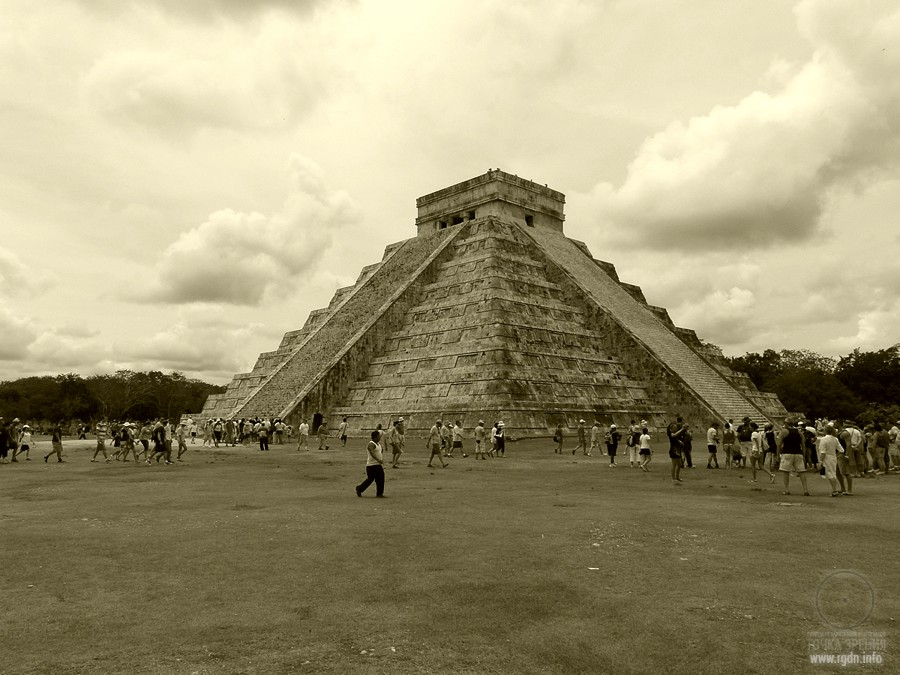
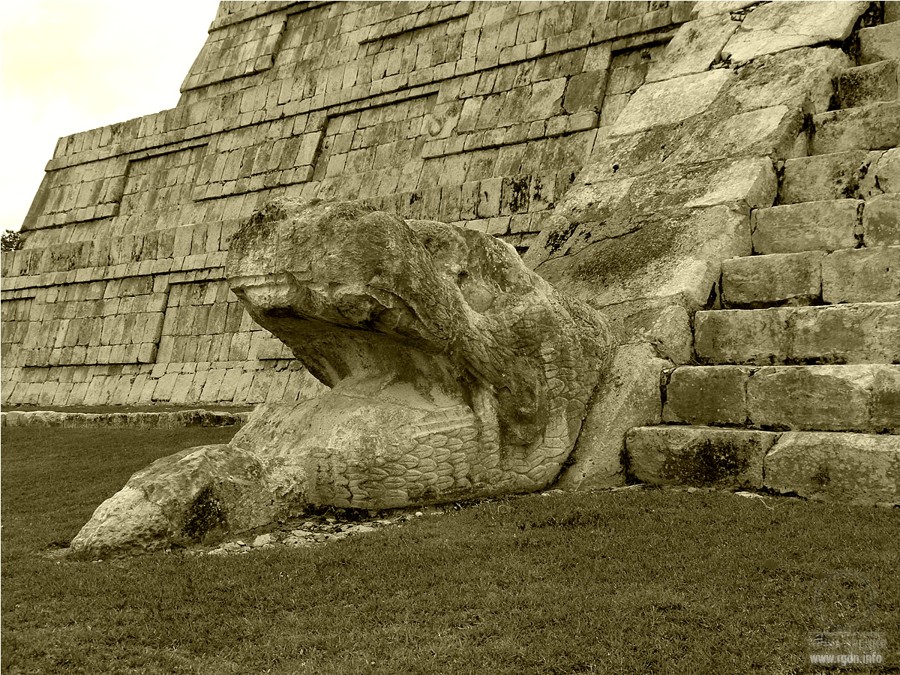
Finally, in myths, ancient cult items, alchemy, yoga and even heraldry there is another frequently used analogue of the Bridge, which signifies the ancient (let me emphasize) spiritual, but not material Knowledge: it’s an image of two twisted serpents crawling up a crosier. And the most ancient artefact depicting such two serpents is the ancient ceremonial
Here it should be mentioned that while preparing a material about the Goblet I read plenty of interpretations of symbols depicted on it, and a definite conclusion unfortunately arises: people interpret images on the Goblet from a purely materialistic perspective, and not from a spiritual one at all. In most cases interpretations of the symbol are given on medical websites in the history of medicine sections, because it is mostly associated with medicine. Yet, there are totally crazy examples when the symbol is associated with reptilian humanoids who manipulate human DNA (no comments)…
Since people who follow the spiritual path are more interested in grains of the true Knowledge rather than in materialistic interpretations of some human minds, I did my best to exclude all medical interpretations from the information on Gudea’s Goblet and left only pure myths, though the latter were full of people’s fantasies as well. Despite such unavoidable fantasies, I still see certain grains of the pure Knowledge in myths in particular.
So, let’s get to the point… )))
In 1877, in the course of excavations carried out on Tello hills (the territory of contemporary Iraq) French archaeologist E. de Sersaque discovered a 23-centimetre one-bottom goblet made of green steatite (the Goblet is now kept in the Louvre). It was later on ascertained that the ritual Goblet had been made for the ruler of Lagash Prince Gudea (22nd century BC) and dedicated to Ningishzida as a decoded inscription on the Goblet said. French researcher G. Contenau believes Ningishzida is a local deity of spring, patron of fertility and healer, otherwise called “the master of the forest of life” or “the sovereign of excess water”. Lagash was an ancient kingdom in Sumer (Southern Mesopotamia) and had a capital city of the same name.
According to other sources, Ningishzida [from Sumerian “sovereign of the pure (holy) tree”] is a chthonic deity, the son of Ninazu, god of the underground kingdom. He was called “the servant of the faraway land” (the underground kingdom), the guard of evil demons exiled to the underground world, protector and patron of Prince Gudea (see Myths of the Peoples of the World. – Encyclopaedia, 1982, V. 2).
On Gudea’s Goblet, there are rather archaic symbols which may be split into two parts by their meaning. The first part includes an image of caduceus (Greek κηρύκειον) in the Goblet centre: two serpents twisting one round the other and around the “crosier” (“sceptre”, or the stem of the tree of life as some sources indicate) the base of which is near the Goblet bottom; jaws of the serpents are directed towards each other and almost touch the water-pouring hollow at the Goblet upper edge (water was supposedly poured during rituals at which gods were asked to grant fertility and life).
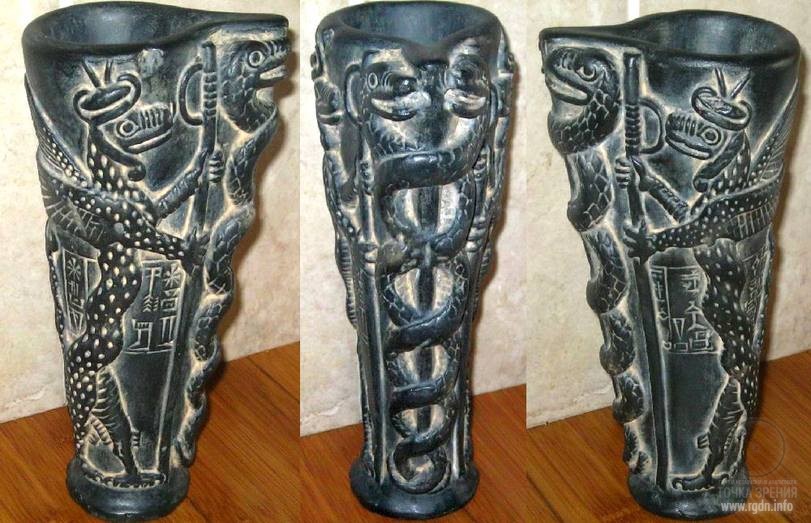
In other words, the caduceus contains two symbols: the twisting serpents and the crosier, both signifying fertility and the life-giving power. At the same time, these symbols make a single whole and demonstrate the evolution of the cult of fertility from phallic symbols to symbols of the unity of two serpents (snakes).
The second part of Gudea’s Goblet symbols, which is inseparably linked with the first part by its meaning, includes the two geniuses that guard and protect the caduceus. Each of these two is a mythical winged monster with a dragon head, a body of a lion or a panther, claws of a predatory animal on its forelegs and of an eagle on its hind legs; each genuis tail has a scorpion sting on its tip. Just like the caduceus, the guarding dragons are almost of the Goblet height. In their hands each of them holds a crosier (or a sword) with a hilt looking like that on Gilgamesh’s weapon (Gilgamesh is a Sumerian and Accadian epic character. Recently, certain grounds appeared to consider Gilgamesh a real historical personality – the fifth ruler of Dynasty I in Sumerian state of Uruk (late 27th – early 26th century BC). Legend says, from Ut-Napishtim, the only man who gained immortality, Gilgamesh found out the secret of the flower of eternal youth and then managed to get it. However, when Gilgamesh was bathing, a snake stole the flower and immediately became younger, having sloughed off its old skin, whereas Gilgamesh remained mortal just like the entire humanity. The geniuses’ hats resemble crowns, indicating their royal status among all creatures the body fragments of which their fantastic hybrid bodies are composed of. They rule over dragons, lions, panthers, scorpions and birds of prey, and are able to protect the vital force symbolised by the caduceus against attacks of those animals by means of the crosier weapon with a magic circle on it.
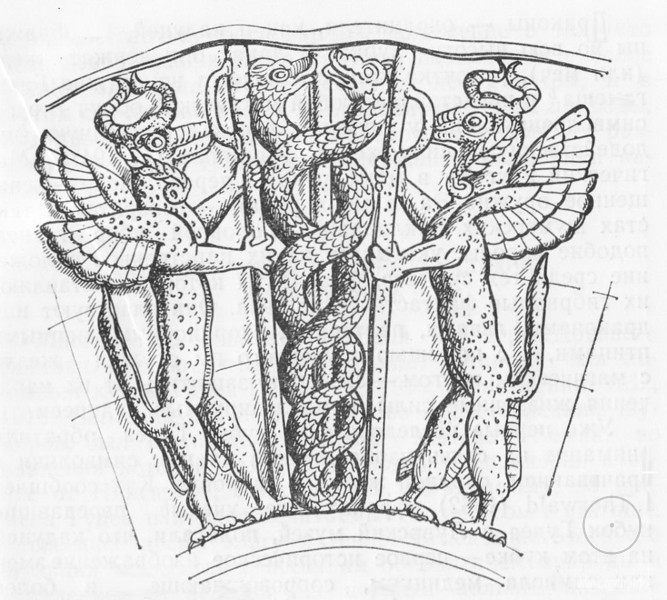
Let’s consider various interpretations of the meaning of the caduceus symbol in more detail.
Many researchers of the history of ancient Oriental culture consider that in Sumerian beliefs Ningishzida to whom Gudea’s Goblet was dedicated was a messenger of the Great Mother Earth, to whose domain he brought heavenly moisture and warmth from Ningirsu in spring. (Ningirsu or Ningarsu – “the supreme ploughman”, “the sovereign of agriculture” – is a Sumerian deity of the circle of Lagash gods. He was regarded as the one to keep order in fields and canals, bear heavenly moisture and establish justice). In Gudea’s time Ningishzida was apparently the most revered deity in Lagash, and so his functions were associated with the springtime revival of nature and cure of diseases. Before the period of complete anthropomorphism he was depicted as two copulating snakes.According to the aforesaid researchers, such symbol embodies the most fertile form of life in the animal kingdom.
Ningishzida brought moisture and warmth into nature; hence he performed functions of a messenger between Heaven and Earth. He was the Earth’s envoy asking Heaven to give rain and warmth to the Earth, promoting fertility, life generation and protection. As for fertility itself, it was ensured by the unity between Heaven and Earth. Ancient people regarded such unity as a process of the Earth fertilization with warm rain – the heavenly semen. The water granted by Heaven gives life to everything on Earth.Obviously, for this very reason the word a (ia) – “water” in Sumerian at the same time means “semen”, “parent”, and “heir” (I.M. Dyakonov. Myths of the Ancient World – М.: Science). Water is a medium, an agent of the universal conception and generation of all things, an equivalent of all vital juices. Therefore, it may be assumed that the most important element in the caduceus symbol is not actually the ancient view of snakes as of bearers of the most fertile form of life, but most probably the idea of the fertilizing role of the heavenly water, the springtime rain, with the emergence of which snakes are associated as “Earth’s messengers” and “mediators between Earth and Heaven”.
It is quite interesting that people of the matriarchy age regarded snakes as water forerunners or water “markers”. Ancient people believed snakes’ connection with water was very deep and versatile. In remote antiquity people saw such connection not only in the fact that snakes lived near water springs, bogs, lakes and rivers, but also in the fact they somehow mysteriously related to such natural phenomena as “waves of clouds”, rains, lightning, rainbows, as well as to relevant weather conditions and fertility. There is plenty of evidence to this.
In particular, very interesting information is communicated by famous historian and archaeologist B.А. Rybakov (B.A. Rybakov. Cosmogony and Mythology of Eneolithic Farmers. Soviet Archaeology, 1965, No. 1, pages 24-47) who studied the Cucuteni-Tripolye culture (4-3rd millennia BC). After thorough examination of paintings on Tripolian ceramic items Rybakov arrived at a conclusion that Tripolians regarded snakes (grass snakes) as rain-provoking creatures. Tripolians compared clouds bringing “living water” to female breasts, and rain streams to milk that streamed from the breasts. One of the typical elements of Tripolian ornaments in the matriarchy age was a serpentine pattern, and one of the most widespread themes in the ornaments was solitary or pair snakes twisting around the Great Mother’s breasts and (probably) sucking or pressing out the milk contained in the breasts (“the heavenly moisture”): perhaps, this symbolized the snakes’ role in emergence of precipitation. Analysing symbols present in such serpentine patterns, Rybakov also concluded that Tripolians attributed protective, guarding functions to snakes. They guard everything valuable: pregnant women wombs, grain reservoirs, etc.
According to Rybakov, the worship of snakes in Tripolye was due to their inseparable link with the water. They appear in fields, crawling out of burrows and slits when rains start, and this, Rybakov believes, was regarded by Tripolians as the snakes’ connection with the Great Mother – the giver of the heavenly moisture. Thus, symbols of the Mother Goddess and the rain (snakes) in Tripolian ornaments are closely interrelated. Tripolians regarded snakes (grass snakes) as mediators between heaven and earth, provoking rains and sucking water out of clouds. Moreover, there is a popular belief of the Neolithic age that grass snakes suck milk of female breasts.

Serpentine patterns on Cucuteni-Tripolye pottery
Tripolian ideas of snakes as mediators between heaven and earth have much in common with Sumerian beliefs of Ningishzida who is depicted as two copulating snakes, called the Earth’s envoy to the Heaven and performs functions of an agent – the Messenger of the unity between heaven (storm clouds) and earth. However, in B.A. Rybakov’s opinion, Oriental peoples regard the serpent not as a mere mediator between heaven and earth, but as the master and keeper of the heavenly water. Such statement by Rybakov further extends our understanding of ancient beliefs relating to snakes’ connection with the water and supports the idea that in ancient times people associated the union (marriage) between Heaven and Earth with sexual intercourse. The sacred union (marriage) regularly recurs in such natural phenomenon as rain with thunderstorm and lightning.
Ancient farmers believed that in spring Heaven came to its spouse Earth as rain in order to fecundate it for the new generation of plants and animals. Heaven was revered as the father and Earth as the mother. For example, Pueblo Indians in Mexico worship “the All-Covering Father Heaven” and “the Four-Times Bearing Multi-breast Mother Earth”. In India, God-heaven has a wife – Goddess Earth. Ancient Greek writers and poets (Aeschylus, Euripides, Hesiod, and others) portrayed the marriage between Gaea–Earth and Uranus–Heaven as rain fertilizing the earth. In ancient Egyptian myths, where the Nile was regarded as a fertilizing principle, Heaven was embodied by the goddess Nut and earth by the god Geb, although in Egypt of earlier times Earth had been worshiped as a female deity.
Ancient ideas of the marriage between Heaven and Earth are found globally, and the symbols of such marriage were ubiquitous snakes.
The fact that Mother Earth personified as the goddess – Heaven’s spouse was depicted as a snake in ancient times is universally recognized and needs no further proof. As for the statement that the revered Heaven was also imagined by the ancients as a snake or serpent, let’s consider several examples evidencing that.
Ancient Egyptians believed that heavenly water kept in the upper heaven above the sun and stars was guarded by the Great Serpent Apep (Apophis). Of its will, the heavenly water streams as rain that fertilizes the earth. By another interpretation, Apep is the embodiment of darkness and evil, the eternal enemy of the sun god Ra. It resides in the depth of the earth where its battle with Ra takes place. When Ra starts sailing along the underground Nile at night, Apep drains the entire water from the river in intention to kill him. During the battle with Apep (which battle takes place every night) god Ra forces the serpent vomit the water back. Such interpretation of Apep’s functions does not contradict the ancient Egyptian idea of the link between snakes and moisture.
The image of a serpent that impedes outflow of the heavenly moisture may be found in myths of other nations as well (e.g. Vritra in Ancient India). In India and Persia, a serpent was a symbol of both the earth fertility and the fire. Since ancient peoples of India and Persia associated water with fire (lightning), the unity between earth and heaven that poured water and fire on earth was embodied in the symbol of two snakes.
Being the water sovereign, the serpent not just gives moisture to the earth, but impedes its outflow from the heaven, too. Thus, in some ancient Egyptian legends the serpent Apep acts as the waterabsorber. In ancient Indian myths Apep’s analogue – demon Vritra, being an opponent of the supreme deity of heaven Indra, blocked rivers up and was depicted as a snake-like creature having neither arms nor legs and hissing. In order to prevent rain, Vritra lay down around clouds. In Vritra’s image the serpent is not only the keeper of heavenly waters, but also the creature that regulates weather: it “closes” rainy weather and sets sunny one. In this mythical image we recognize the rainbow which in Slavic popular beliefs is known as indicator of termination of rain and emergence of warm and sunny weather.

For centuries, when Russian peasants noticed a rainbow in the sky in a rainy weather they’ve said it’s a herald of the weather change. Rainbow as if “locks up” the outflow of heavenly moisture and thus eliminates bad weather. Such idea is typical for other nations as well. In African beliefs, Mongolian, Japanese, American Indian myths there were images of a serpent as the lord of heavenly water and weather, whereas many peoples of the East regarded snakes as water absorbers, mostly represented by a rainbow.
Ideas of the serpent as the lord of heavenly water and weather were spread among many Oriental peoples. According to the Vietnamese, whether black clouds float across the sky, pouring fertilizing rain, or a tornado whirls, or mist curls over rice crops – all this signifies the mighty dragon (great serpent) that brings fertility to the earth. Dragons are protectors and patrons of the earth and all living beings on it (“the legend of Leo Lohe”).
In China dragon is the lord of rain, embodying the Yang masculine principle that merges with the feminine principle Yin (Yan is fire, Yin is water). The ancient Chinese saw dragon in clouds or swimming in water, and it was always enveloped with tongues of flame, coming from its shoulders and legs. Water is the external environment, while fire is the internal essence. Dragon represents the unity of the powers of heaven and earth, fire and water. It’s a springtime thunderstorm when streams of fruit-bearing shower join with lightning flashes. The unity of heaven and earth is the source of fertility, abundance and wealth. Apparently, for the same reason Melanesians believed that the serpent was a creator of everything and its phallus was a bearer of the entire vital force and good fortune.
The New World peoples had a similar cult of a serpent as the master and keeper of heavenly water. Their serpent was always associated with rain and weather. For instance, the cult of rain and lightning was the most ancient and important for Aztecs, since it made seeds germinate. In all such myths of different peoples, no matter which functions the serpent performs (the heavenly water giver, keeper or absorber), it always plays a role of the master of weather conditions, the owner of rain and spring waters; it is always great, heavenly and fiery.
Since in ancient times people regarded the marriage between Heaven and Earth as the foundation of life, it becomes totally clear why they worshiped attributes and symbols of such sacred marriage as a guarantee of fertility, prosperity and life preservation. Such symbols altered over time though: while in the hunting age the fundamental principle and bearer of life was phallus – the symbol of the masculine fertilizing power that ensured reproduction (fertility) of animals, in the agricultural society people could not but associate fertility with natural phenomena and water that vivified and fertilized the earth. For a farmer, water was heavenly semen. Fecundating Earth with water, Heaven provides fruits of its marriage to all living beings. This marriage, the outcome of which is fertility and life, is exactly symbolized by caduceus: two copulating snakes as attributes of the water element and the most fertile form of life twist around a crosier or baton – the phallus.
Caduceus as a symbol of fertility, life, preservation of life and wellbeing was widespread in Mesopotamia. Along with it there were diverse depictions of Ishtar, the goddess of nature, fertility, maternity, love and life, as well as of other deities of earth and heaven. For instance, Babylonians (the successors of Sumerian culture) depicted the solar deity Shamash.

Caduceus may be found on stamps of rulers and sages in different cultures and lands. Babylonians widely used caduceus as a symbol of fertility and wellbeing.
Images that reflect the same idea in a symbolic form have reached us in Indian stone sculptures – dildoes – stone phalluses combined with two snakes. Hindu women made sacrificial offerings to such sculptures and performed special rituals accompanied by entreaties of child birth, preservation of newborns’ life and health, and long life for their husbands.
Hindu dildoe and Sumerian caduceus have another similar analogue: two twisting snakes combined with a cult cone on Carthage pillars. A similar-type image is also represented in Lubian stone cone-shaped sculptures with two copulating snakes on the cone sides. In all these cases the symbol of two snakes reflected primeval ideas of the productive forces of nature, problem-free development and preservation of life.
In Zoroastrianism, water was regarded as the most important element for a human being and was called “Ahura Mazda’s daughter” – “the queen of heaven”. According to this teaching, since water bears life and ensures its preservation, it must be perfectly pure (L. Meunier. History of Medicine. 1926).
In the antique world and subsequent ages the caduceus symbol, as the one indicating the unity between heaven and earth, fertility and wellbeing, started gaining the meaning of success, good fortune, peace, concord, eloquence, favourable course of affairs, wisdom, and last but not least happiness and prosperity. Since in the economy of antique countries prosperity, happiness and success were associated not only with farming, but with trade as well, caduceus mostly embodied commerce and was considered an attribute of Hermes / Mercury.
In ancient Greek myths Hermes is the patron of pastures and herds, roads, commerce, gymnastics, and eloquence. He was portrayed as a young man with caduceus in his hand, a hat on his head, and winged sandals on his feet. Pillars with his image (herms) were placed on boundary paths and crossroads. In Egypt of the Hellenistic period he was associated with Thoth.
By means of caduceus Hermes opens the gate of the underground kingdom (πύλος, hence there’s Hermes’s epithet – the Doorkeeper, Πυληδόκος) and leads there souls of the deceased. The name caduceus was most probably adopted by Romans from Greeks: καδδῦσαι, pl. καταδύω (= καταδύνω) καταδύνω (καταδύνω) meaning to invade, to get deeper, to penetrate, to enter.
According to myths, Hermes bartered a crosier (σκῆπτρον) from Apollo, having given him a lyre made of tortoise shell. The crosier had a property of stopping disputes and reconciling enemies. When Hermes placed the crosier between two fighting snakes, they immediately stopped biting each other and peacefully twined around the crosier. Caduceus is carried by all envoys as a symbol of peace and security; it is their major attribute and guarantee of their immunity.

Caduceus was the attribute of not just Hermes / Mercury, but also of the Egyptian god Anubis. It is considered that Greek poets and myth composers initially adopted this symbol from Egyptians, and later on Romans adopted caduceus from Greeks.

Such item is also found in the hands of Phoenician Baal and sometimes in the hands of Isis and Ishtar.
The second part of Gudea’s Goblet symbols is represented by the two geniuses depicted as hybrid monster dragons that stand on the caduceus sides. They have the attributes of royal power and crosiers of the supernatural magic force, and their function is to guard the caduceus.
Why were monster dragons, possessing the attributes of power and the magic weapon, assigned to guard life and its evolution? Which ancient beliefs are hidden behind such symbols?
Earthquakes, cyclones, volcanic eruptions and floods that frequently ruined vast territories and were accompanied by winds, heavy showers, thunderstorms and lightning at the end of which a rainbow appeared, due to an external resemblance of waves, clouds, lightning and rainbows to a snake, were personified in a mythical image of the Great fire-spoutingSerpent-Dragon, the master and keeper of heavenly water. Under such circumstances people perceived water not as the life-giving “heavenly semen”, but rather as the element that brought chaos, darkness, night, cold, and death. Perhaps, for this very reason Sumerians had multiple meanings of the word water: on one hand, it related to conception and extension of life and was a part of the semantic line: water – semen – parent – heir, whereas on the other hand (more often as a plural noun) it was associated with darkness, disaster and death (the semantic line: death – disease – darkness – night – cold – water).
Yet, no matter how often natural disasters took place in ancient times, they were still not the ones to determine ancient people’s ideas of the role of water in their life. The ancients, e.g. inhabitants of Mesopotamia, observed annual cyclic changes in flora and fauna and linked those to seasonal changes in water conditions. We can assume such changes exactly caused the emergence of ideas of the “living water” that brought life and fertility, and the “dead water” – probably the one poured out of clouds in autumn and in winter with no thunderstorm, lightning and rainbow. As ancient people believed, the “dead water” determined nature’s “dying” in autumn. At that, water does not stream to the earth by itself. It ultimately depends on its master and keeper – the serpent, the dragon – whether it will come to the earth as vivifying spring rain (the fertilizing heavenly semen) or as ruinous flood bringing destruction, chaos, and death. Thus, the Great Serpent as the master of water has power over human health, life and death.
This has been a brief presentation of Gudea’s Goblet symbolism, including relevant ancient myths as well as modern interpretations and fantasies.

Now let’s consider a brief hint of decryption of the aforesaid images, as may be found in Birds and a Stone book by Anastasia Novykh:
“Look at the pattern. Referring to your description of the processes taking place in one’s brain during the spiritual practice, here hypothalamus is represented in a form of an ancient dragon, say, the external Guard, in a double form besides, which opens the door for epiphysis stimulation. Remember, you said that in yoga this association is connected with a snake ascending along one’s spine... Do I understand correctly that these images on the goblet mean ciphered knowledge?!”
“What can I say?” Sensei smiled. “I’m glad this time my words haven’t turned into just another air vibration for you. Yes, it’s true. The goblet pattern depicts the entrance to the Portal through hypothalamus and epiphysis stimulation.”
***
“Oh, fibbers, unique fibbers!” Sensei commented, laughing. “A chthonic deity”... Clowns! Speaking in Russian, Ningishzida was simply Sokrovennik, and Ningirsu was Mezhanin.
…Mezhanin is a person having access to Shambala through the Threshold and communicating directly with Mahatmas. And Sokrovennik is a disciple of Mezhanin, also possessing certain spiritual knowledge. He is able to attend only the Threshold of Shambala... “Ningishzida” in Sumerian means “the master of pure (holy) tree”. Better to say, he possessed certain knowledge of Shambala science. “Ningirsu” is translated as “the main sower”, later they started translating it as “the supreme ploughman”, “the master of agriculture”. Enlil is one of the names of Mahatma belonging to the seven Bodhisattvas of Shambala.”
***
“It’s always like this: for crowd such information is given in entertaining associative images, whereas for versed people it’s given as knowledge for internal work.”
“I'd like to ask also the following. Why are there two twisted snakes depicted on the goblet, ascending the baton?”
“Well, firstly it shows the specific moments of epiphysis stimulation during the spiritual practice... Secondly, two snakes in Oriental symbolism belong to one of Shambala symbols translated as “the Threshold”. And, thirdly, prior to the period of complete anthropomorphism...”
“I haven’t got it, what?” Max asked to repeat.
“Representation of human forms... So, in ancient times gods were depicted in animal forms. And a serpent was one of the major symbols. Two twisted serpents meant “bringing an abundant fruit”, i.e. personified the most fertile form of life. And each person got one’s own notion from that definition, in accordance with one’s inner evolution level.”
***
“As a matter of fact, Gilgamesh was a completely real man, the fifth ruler of the first dynasty of Uruk, a Sumerian city-state. And “the eternal youth flower”, which the ancients also called “the immortality plant”, “the immortality herb”, was nothing else but lotus the seeds of which preserve germinating power for thousands of years. Ut-Napishti’s knowledge was indeed revealed to Gilgamesh. Working on his internal, he became able to attend the depth of his consciousness and perceived a lot. However, he failed to pass the Guard-Serpent, i.e. to overcome his animal nature. Therefore, he remained mortal.
You see, life puts barriers on your way, so various that are even hard to imagine. They are intended only to stop you. The higher a person ascends spiritually, the grosser those barriers may be. At that, if the person doesn’t care a damn for them, they simply vanish like a mirage, like an illusion. They actually don’t exist at all. Yet, when a person is entrapped by his or her animal nature, it evidences that he or she is material, is in conflict with oneself and does not fully belong to the spiritual. When the person gives up, it means he or she does not deserve abandonment of the reincarnation circle...”
***
“I’ve also noted that, in the first ancient civilizations in Mesopotamia, Egypt, China, the fertility cult was interlaced with water element idolization, with the idea of a dying and reviving god of grain and, again, with totemic bull and snake images. At that, snakes were called “living near the spring”. So I thought, if information is encoded in images, the “spring” should in principle mean “pure knowledge”... Then some other interesting facts cropped up. In Babylon a snake was called nothing else than “a child of the Earth goddess”, in Europe – “the life of the Earth”, and snakes were often depicted as an ornament on kings’ and pharaohs’ crowns. Yet, what is most interesting is that many nations of the world had similar conceptions. By the way, “life” and “snake” in Arabic are pronounced equally: “el hai”. And there is same coincidence in languages of many Indian tribes...”
***
“Moreover, I’ve got very interesting information relating to Slavs. It turns out that Russian people wore serpentine guarders from time immemorial, and such guarders were considered being able to protect from all diseases and troubles. It’s written that the serpentines origin is rooted in the remote thousands of years.”
“Yes, they were used in Sumer and much earlier,” Sensei added. “They existed in the antiquity of which you’ve never even heard.”
Max kept quiet for a while and then added:
“You know, the image on such serpentine guarder has interested me as well. The most ancient Russian serpentine guarders had a round shape. Seven- and twelve-head snakes or dragons, other monster guarders were depicted on one side. And on the other side there was...”
“The sun containing a triangle with an eye inside,” Sensei finished the sentence.
“Exactly!” Max said dazedly. “Later, when Christianity appeared, this antique symbol regarded as pagan was replaced with an Archangel image. So, together with snakes it became shaped as a peculiar combination of pagan and Christian elements... And what is this sign?”
“It’s the Shambala stamp.”
“The Shambala stamp?” Eugene and Volodya asked almost in chorus.
“With Slavs?” Max uttered perplexedly.
“Why are you so surprised?” Sensei shrugged his shoulders. “The Slavs are a nation distinguished long before its birth and formation. In Slavs a tremendous spiritual potential is concealed, capable of changing the whole world. Therefore, they are distinguished, say, from their birth with a Shambala sign. By the way, this sign can be found nearly in every church. Some Russian tsars were crowned under this sign.”

13th century Old Russian serpentine guarder with the image of Theotokos Oranta (Mother of God of the Sign)

Such interesting hints of decryption of Gudea’s Goblet symbols are given in A. Novykh’s Birds and a Stone. As readers can see, the information in the book hardly resembles popular fantasies relating to the symbols connection with healing or moreover with alien experiments on human DNA.
Let me also add my personal conclusions on Gudea’s Goblet as a representation of the Bridge:
In conclusion of the article I would like to present a couple of images that might provoke certain reflections in readers:
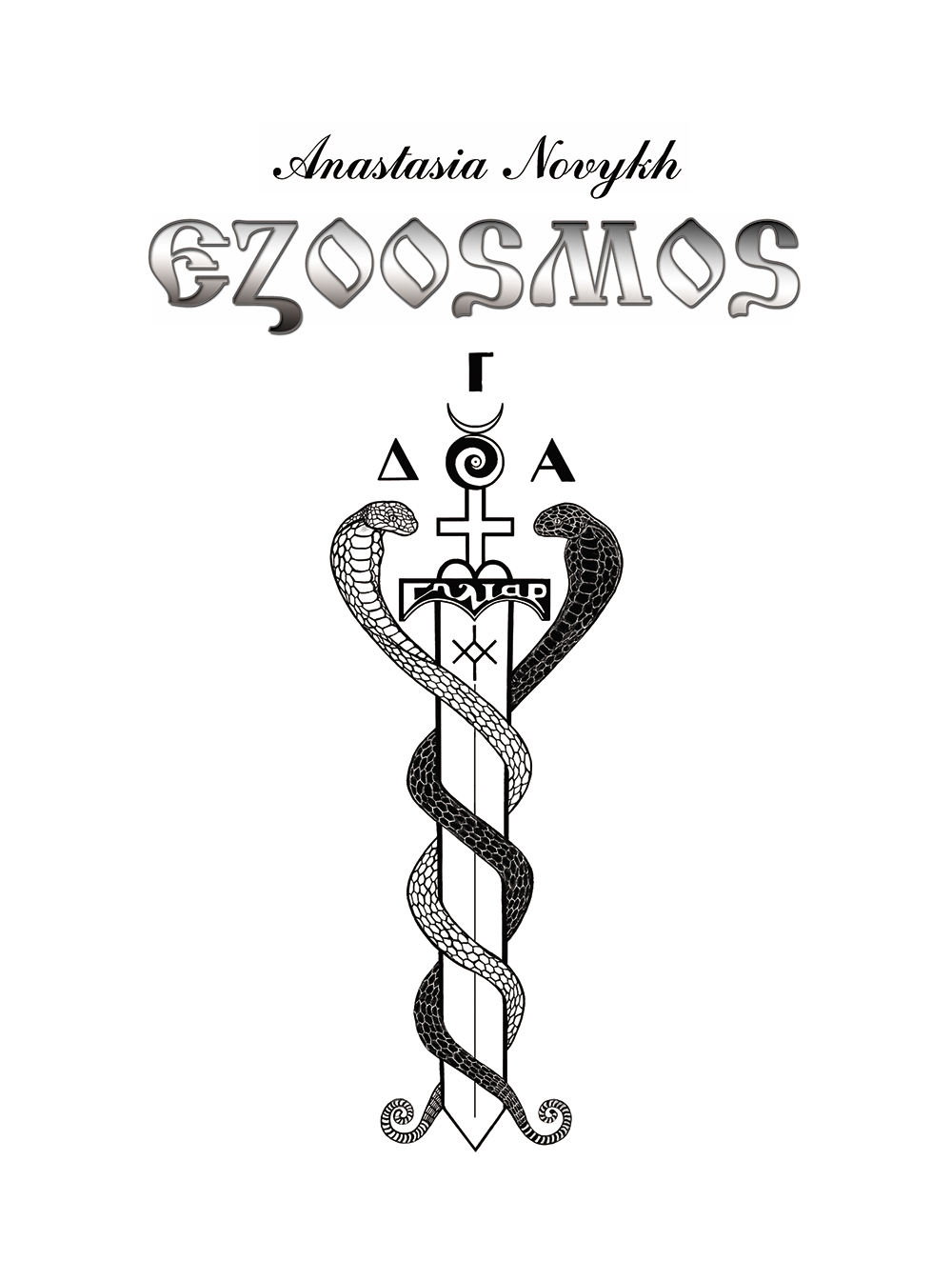

Prepared by Niva (Russia)
Sources:
http://www.liveinternet.ru/users/vissarion/post264653136/
http://www.doctoribolit.ru/?go=Istoria/Istoria_001_2
https://ru.wikipedia.org/wiki/%D0%9C%D0%B5%D1%80%D1%83
https://ru.wikipedia.org/wiki/%D0%9C%D0%B8%D1%80%D0%BE%D0%B2%D0%BE%D0%B5_%D0%B4%D1%80%D0%B5%D0%B2%D0%BE
 Gudea’s Goblet
votes:
274
Gudea’s Goblet
votes:
274
|

Project Aim










Leave comment